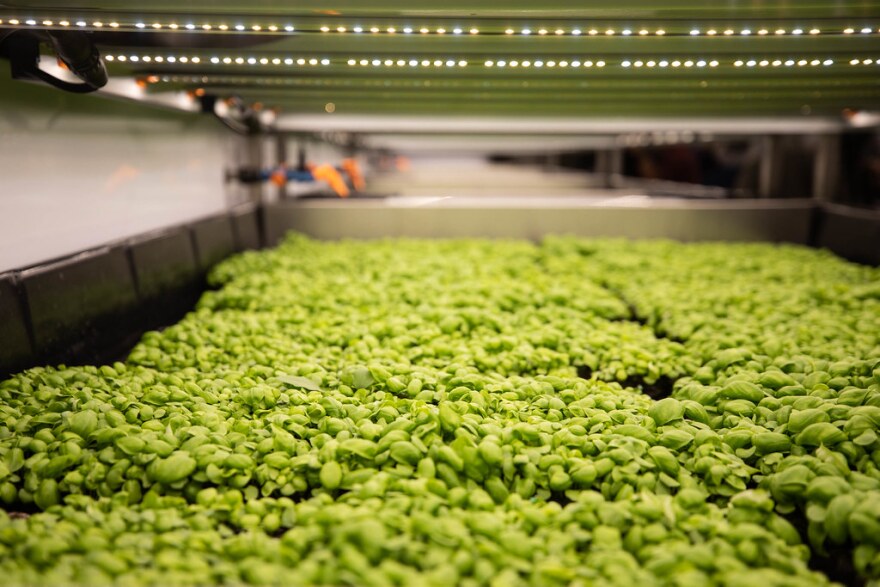The Iron Ox greenhouse sits in a quiet part of Lockhart, across the street from a state prison. Inside, the Silicon Valley-based outfit grows various varieties of leafy greens, like lettuce and basil. it has plans to add tomatoes and strawberries in the near future.
But it’s not so much what they’re producing, as how they’re doing it, that caught the attention of Texas Standard’s Michael Marks, who recently visited the facility. Listen to the interview above or read the transcript below.
This transcript has been edited lightly for clarity:
Michael Marks: Iron Ox is one of a few companies that are getting into high tech indoor farming. This one is founded by a Texan named Brandon Alexander, who used to work for Google. And what they’re doing is they’re trying to use robotics and artificial intelligence to improve agriculture. So this is actually their second greenhouse. They also have one in California. And the one in Lockhart is really big – over 500,000 square feet with these tall ceilings.
The greenhouse is a full service operation. They handle everything from planting to packaging. Overall, the place kind of feels like a plant nursery front, “The Matrix.” They grow these plants in these six-by-six foot modules. And that’s where their whole life kind of takes place. Most of the growth happens in one of two big rooms. One is filled with what look like library shelves because the racks are all filled with plants and they’re underneath these LED lights. And the other is the greenhouse itself where the trays. Just sit on the ground and get shuttled around by robots.
Texas Standard: Can you say a little bit more about the technology that they’re using? Did you say artificial intelligence?
Michael Marks: They use AI as well as robotics. One of the robots is called Grover, which looks a little like a giant Roomba. Its purpose is to move these trays around the greenhouse, and when they’re full with plants and water, they weigh over 1,000 pounds. One of the places that Grover takes the plants is to another robot called Phil. Phil uses a sensor to detect what a given set of plants needs – so maybe more of a certain type of nutrient or water. And then it releases that mixture into the tray. So it fills it up. Get it?
The AI and data collection comes in where they photograph these plants from multiple angles over their life cycle in order to gather tons and tons and tons of data about how well a particular plant is growing. One of the folks who talked to us about this is Peter Chang. He’s a senior computer vision engineer at Iron Ox.
Peter Chang: So every single plant that we’re harvesting and that we’re growing and scanning, those provide the information for us to feed back into our systems and improve the way we grow our plants.
Texas Standard: How do the pros and cons stack up when you compare with what a company like this is doing versus more traditional egg?
Michael Marks: Well, the data is an advantage. Of course. The idea is the more data you gather, the better you get the plant, the more efficiently you grow it. Also, growing indoors and controlling the climate is a huge advantage. You think about how the climate is changing and the effect that’s having on farmers, as well as issues like herbicide drift, pests, insects. Those are all taken out of the equation. And you can grow anything anywhere more or less any time. Seasons are not so much a consideration.
The flip side is that there is a lot of overhead. Traditional farming is not necessarily cheap but this is a different level of expenditure in terms of what is required to get started. And also robots are better suited for some tasks than others. It’s easy for a human to pick pecans or watermelons or oranges. But those sorts of things are tougher for robots, which is why they’re starting with leafy greens.
Texas Standard: Is this the future of agriculture – automation, data science? Is that where we’re headed?
Michael Marks: Certainly to an extent. Most of the experts I talked to expect that in the medium to long term, indoor ag will take part of the produce market from traditional sources. The question is, how much of the pie do they take? That’s kind of difficult to say. But the other end of this is that you also have, more “traditional” farmers and big ag companies integrating some of this technology into their operations. So you think about drones and automated harvesters, apps to monitor moisture levels in irrigation.
And something that I didn’t mention when talking about the pros and cons is that growing indoors allows you to get closer to the customer. One of the folks who I talked to for this story was Katie Seawell, and she’s from Bowery, which is another indoor farming group. They’re putting in a facility in Arlington. And the reason they’re doing that is because there are so many people there.
Katie Seawell: There is just great commercial attractiveness in the state and the market. We will be able to serve 16 million people within a 200 mile radius through our farm.
Michael Marks: So one of the main factors that’s driving the growth of these kinds of operations in Texas is the fact that this is an increasingly urban state and that we have dense population centers. Growers like Iron Ox and Bowery think they can get their produce to a lot of people without having to transport it along way.
Copyright 2022 KUT 90.5. To see more, visit KUT 90.5.


